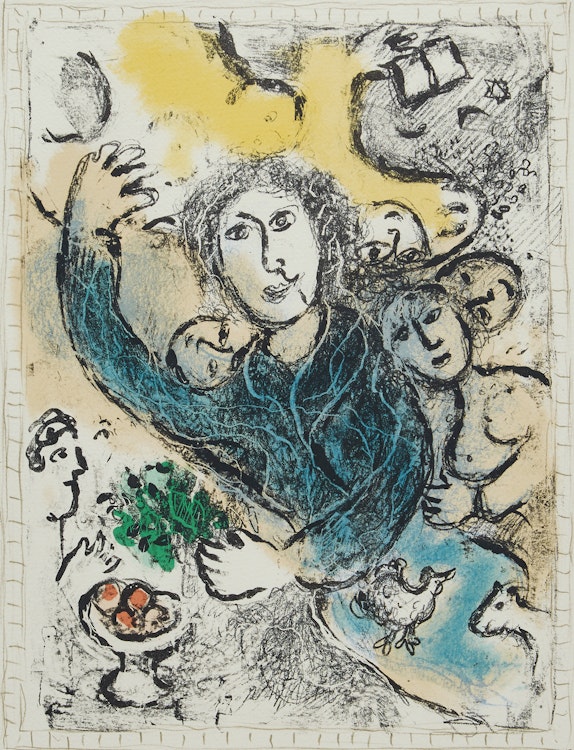L’Artiste II (M.929) by Marc Chagall

Marc Chagall
L’Artiste II (M.929)
colour lithograph
signed and numbered 44/50 in the lower margin; titled and dated 1978 on a gallery label on the backing on the reverse
19 x 15.25 ins ( 48.3 x 38.7 cms ) ( sheet )
Auction Estimate: $5,000.00 - $7,000.00
Price Realized $7,200.00
Sale date: June 8th 2023
Albert White Gallery, Toronto
Canadian Corporate Collection
Charles Sorlier, “Chagall Lithographs, 1974-79”, Monte Carlo, 1984, page 12
In 1948, Chagall produced his first major lithography series, "Arabian Nights", illustrating the Middle Eastern and South Asian folk tales known as “The Thousand and One Nights”. Lithography provided the opportunity to use the same rich colour palette he was known for
in his paintings. In the early 1950s, Chagall began a friendship and long-term collaboration with the master printer Charles Sorlier. Sorlier worked at Imprimerie Mourlot, a lithography studio in Paris where artists including Picasso, Braque and Miró also made prints. Chagall would continue to work with Sorlier right up until the artist’s death in 1985, at the age of ninety-seven. Together, they found innovative ways to fill the artist’s compositions with dozens of unique colours.
In addition to his lithography series, Chagall produced many individual prints, including “L’Artiste II”, a self-portrait from 1978. Outlined in black and accented with teal, yellow, green and red, the composition includes some of the artist’s signature motifs, such as the rooster and goat in the lower right corner. Sorlier wrote of Chagall’s creative printmaking process: “With Chagall, nothing is quite as we expect it's going to be. He has the rare ability to start each morning afresh. For him, each day is the first day, each flower the most brilliant, each fruit the sweetest... With every stone, lithography is born again... I have had the rare privilege of seeing Chagall at work, and it cannot be denied that, at times, it seems as if an angel has entered the workshop.”
Share this item with your friends
Marc Chagall
(1887 - 1985)
Marc Chagall was a a painter, lithographer, etcher and designer, born on July 7, 1887, in Vitebsk, Russia. He studied in Saint Petersburg and later with Léon Bakst. He moved to Paris in 1910, where he was introduced to Fauvism and Cubism while associating with Guillaume Apollinaire, Robert Delaunay, Fernand Léger, Amedeo Modigliani and André Lhote. In 1912 he participated in the Salon des Indépendants and the Salon d’Automne. His first solo exhibition was held in 1914 at Der Sturm gallery in Berlin.
Chagall visited Russia in the same year and, due to the outbreak of war, was prevented from returning to Paris. He settled in the province of Vitebsk, where he was appointed Commissar for Art in 1918 and founded the Vitebsk Popular Art School. After moving to Moscow, he executed his first murals for the State Jewish Chamber Theater. Following a brief stay in Berlin, he returned to Paris in 1923, where he met the French art dealer Ambroise Vollard. Chagall had his first retrospective in 1924 at the Galerie Barbazanges-Hodebert.
Along with other artists, such as Max Ernst and André Breton, Chagall fled France for the United States during World War II. The Museum of Modern Art in New York held a retrospective of his paintings and graphic works in 1946. Despite settling permanently in France in 1948, the large-scale commissions he received led him to travel extensively across Europe in the following years. Among these were windows for the synagogue of the Hadassah University Medical Center in Jerusalem, a ceiling for the Paris Opéra, a memorial window for the United Nations headquarters in New York and windows for the cathedral in Metz, France.
In 1973 the Musée Chagall was opened in Nice to house his Message Biblique (Biblical Message, 1956–1966), consisting of seventeen canvases on biblical themes. A major retrospective of his work was held at the Philadelphia Museum of Art in 1985, the same year that Chagall died in Saint-Paul-de-Vence, France.

